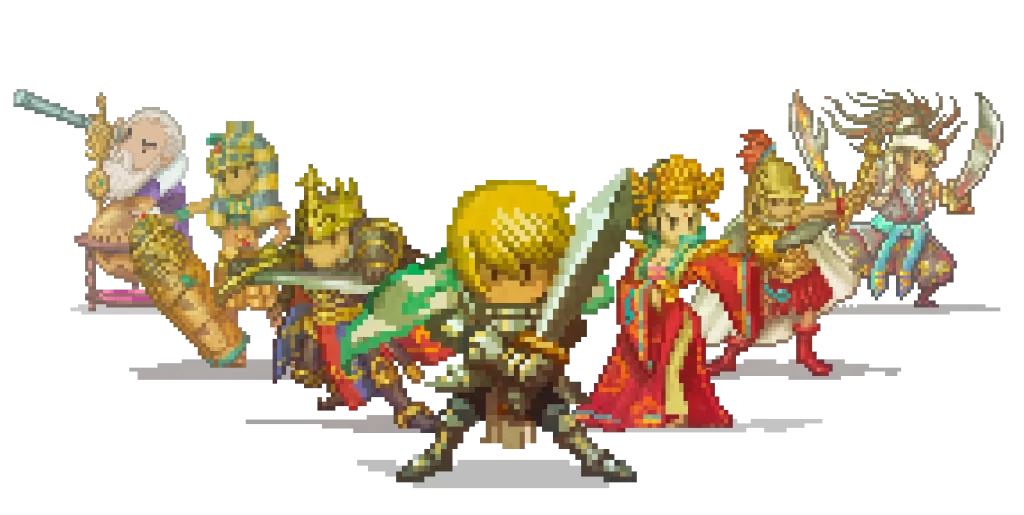From the early days of Pong, Tetris, Break Out, and Space Invaders, the gaming industry has come a long way – it’s hard to believe that in just a few decades they went from being casual pastimes to a behemoth projected to generate a staggering $372 billion in revenue by the end of the year.
With an industry this big, there are tens of thousands of titles available to play, each offering a unique experience and catering to players of different interests and skill levels.
In this article, we’ll explore the different types of games that exist, going from traditional ones to more modern ones. Join us on this journey through the gaming world, and hopefully, you’ll uncover new games to add to your collection!
Read as well: What are blockchain games, after all?
The 7 main types of games on the market

Classic board games
Despite their extensive history, classic board games are among the most popular types of games for social gatherings. They are also known as “tabletop games” as they are meant to be played on top of a flat surface, such as a table. Such games are usually played with specific game pieces, cards, dies, and even a huge and intricate board, and often involve some form of strategy, skill, and luck.
Two classical examples are chess and Go, both very popular abstract strategy games. Their rules are relatively simple to understand and put to practice, but truly mastering them is something that takes decades for the average person – and that was the reasoning behind chess and Go being the games of choice for supercomputers like the AlphaGo to learn.
As far as modern tabletops go, there is something for everyone: classical role-playing games (like the infamous Dungeons & Dragons and Pathfinder), card games (like solitaire, poker, and Uno), dice games (like bunco and craps), paper and pencil games (like Sudoku and Battleship), board games (like the potentially friendship-ruining Monopoly), tile-based games (like mahjong and dominoes), jigsaws, and much more.

Arcade games
Arcade games are a type of game that first appeared in the early 1970s and was popular for decades to come. Commonly found in arcades, amusement parks, and other entertainment venues, arcade games were played on specialized computers that had simple, but highly addictive gameplay, flashy and colorful visuals, and posed a challenge for most people, who were happy to insert a coin for an attempt at a high score.
As such, these games were designed to be easy enough for people to learn quickly but still challenging enough so that only a handful would conquer all levels. To go far, players had to resort to their snappy reflexes and deep strategic thinking to progress through the levels without losing all their lives.
Indeed, arcade games have seen better days – they are among the least popular types of games nowadays – but they introduced many to the wonderful world of gaming, being a key element behind the overwhelming success of the gaming industry. Examples of arcade games include the universally-known Space Invaders, Donkey Kong, and Pac-Man.
Indie games
Also known as independent games, indie games are a type of game developed by small teams (or even a highly dedicated solo developer) without the financial help of major game publishers. For this reason, their scope and visual quality are often limited by budget and resource constraints, but that doesn’t mean indie games cannot be masterpieces.
As indie developers often prioritize innovation and creativity over commercial success, their games are often the stage for unique and unforgettable gaming experiences for players of all backgrounds, offering a refreshing take on many game genres.
In recent years, indie games have become an increasingly popular type of game, and their rise to stardom can be linked to the popularization of digital storefronts like Steam and Itch.io, better and more efficient tools for designing and developing games, and their lower prices while still offering a polished, high-quality gaming experience.
Furthermore, they also come in all shapes: from puzzle games like The Witness and Braid to tower defense titles like Bloons TD 6, there is something for all tastes, no matter how niche and specific they are. Some games even managed to go mainstream and receive universal acclaim, like Stardew Valley, Celeste, Undertale, and Hollow Knight.

AAA games
If indie games are like the underdogs in this extremely competitive industry, AAA games are the top dogs. They typically have budgets that surpass the tens of millions of dollars (with some games reaching well over $300 million), extensive marketing campaigns spanning multiple years and media types, extremely high production value, and are developed by already established game companies with hundreds of professionals, which give AAA games a leg up in the market.
AAA development companies often have the advantage of working with bleeding-edge technology, which allows for more ambitious game design and even a chance of a technical breakthrough. Furthermore, this type of game is developed with mass appeal in mind, with striking visuals, great sound design, high levels of UX polish, and straightforward gameplay mechanics being core traits of AAA games.
That said, this production level and huge market expectations don’t come without potential downsides: AAA games are often more expensive than their indie counterparts, and their focus on mass appeal might stifle innovation and creativity in their storytelling and gameplay mechanics, as developers would rather meet the market’s demands over taking risks.
Ultimately, their long-awaited releases, immense replay potential, and their tendency to set trends for the gaming industry make AAA games impossible to miss, with franchises like Assassin’s Creed, Grand Theft Auto, Red Dead Redemption, The Elder Scrolls, and Resident Evil being among the most cherished experiences in the gaming world.

Live service games
Also known as games as a service (GaaS), they are a type of game that is designed to provide regular content updates over an extended period of time. As a result, these games almost always require an internet connection to play.
One of their key characteristics is their focus on player engagement and retention, with regular content drops being one of their biggest selling points. These updates can include new levels, characters, game modes, missions, cosmetic items, collectibles, achievements, and whatever else the content team finds interesting.
For this reason, they are also more prone to listening to the valuable feedback their players provide, sometimes even involving the community in some development processes (like conducting polls and being in close contact with some of the game’s main personalities). This allows players to feel some sense of ownership and influence over the direction of the game, which helps foster a dedicated and loyal player base.
Another thing that sets them apart as a type of game is their business model. Most games are offered for free or require a one-time, upfront payment, but not most GaaS – instead, they usually opt for freemium (where the base game is free, but players can get additional content/microtransactions through real money) or subscription models (which are usually renewed every month). This in turn ensures an ongoing income stream, which supports the continued development and maintenance of a live service game.
Examples of live service games include the sci-fi looter shooter Warframe, the Diablo-like ARPG Path of Exile, and the battle royale Fortnite.

Mobile games
Even though smartphones were only brought to the world by Apple back in 2007 (yes, it’s been 16 years already!), it didn’t take long for them to dominate the market. It was like watching history unfold in front of our eyes, and no one at the time could have predicted how much of our lives revolve around said devices.
As their capabilities evolved, so did the market on all things mobile phones, and games were one of the cornerstones they found. Nowadays, according to Statista, almost 7 billion people own a smartphone, and mobile games are one of their favorite pastimes.
This type of game also comes in various forms, which include puzzle games, strategy games, fully-fledged MMORPGs, casual games, NFT games, and many more. While some games may only feature touch-based controls, more advanced titles can offer swipe gestures and tilt controls, increasing the opportunities for game designers to shine.
As far as their mechanics go, mobile games often incorporate freemium features: even though the base game might be free, you might be generating small amounts of revenue by simply playing their game as ads are a common annoyance. It’s common for mobile games to offer in-game skips and other convenience-based microtransactions (also known as in-app purchases), like ad blockers, cosmetics, and resource/experience boosters.
Furthermore, mobile games are well-known for incorporating cross-play potential between iOS and Android players, and they often have social features, like multiplayer options, leaderboards, and in-game guilds, which further enhance the gaming experience and foster community engagement.
Some examples of mobile games include Raid: Shadow Legends, Temple Run 2, Alto’s Adventure, Pokémon Go, League of Legends: Wild Rift, and Genshin Impact, one of the top-grossing games of all time.
Casual games
Last, but not least, come casual games. As the gaming market grew more popular and spread across the globe, developers quickly realized that not everyone wants a complex or hardcore gaming experience requiring dozens of hours to complete.
In fact, this type of game often doesn’t require a captivating story, next-generation graphics, or deep and complex gameplay mechanics. Sometimes, all they require to be a successful casual game is some straightforward game mechanics, pretty and cohesive visuals, and great UI/UX design to ensure the game is as accessible as possible.
Another key trait of this type of game is its simple and clear objectives, or sometimes no goal at all, closely resembling the sandbox game genre). Animal Crossing: New Horizons and The Sims 4 are perfect examples of casual games, and so are party games like the Mario Party franchise – everyone can join in on the fun, as the controls are easy to learn, the minigames a diverse, and play sessions are often short, making them a perfect activity for social gatherings.

Diving into the diversity of video game genres
The world of video games is a vast and diverse one, offering gamers an array of captivating experiences through different types of video games.
- Adventure games take players on narrative-driven journeys, often involving puzzle-solving and exploration, while simulation games provide virtual environments for gamers to immerse themselves in.
- Real-time strategy games (RTS) challenge players’ tactical skills in managing resources and armies, while sports games recreate the excitement of various athletic events.
- Survival games test gamers’ ability to thrive in hostile environments, and multiplayer games provide a social platform for gaming enthusiasts to interact and compete.
- Fighting games allow players to engage in one-on-one combat, and action-adventure games combine the thrill of action with intricate storytelling.
- Tactical role-playing games (RPGs) emphasize strategic decision-making, while survival horror games instill fear and suspense.
- Tower defense games focus on protecting a base from incoming threats, stealth games require sneaky tactics, and MOBA games involve teamwork and strategy in a competitive arena.
- Hybrid genres merge elements of different types of video games, resulting in unique gameplay experiences.
The truth is that, from epic battles in turn-based strategy games to the thrill of hidden object games and the intensity of battle royale games, the video game industry boasts a rich tapestry of game genres, offering something for every gamer’s preference. Whether revisiting early graphic adventure games or exploring the latest subgenres of strategy video games, there’s a whole world of gaming adventures awaiting discovery!
Don’t miss: Top games made in Unreal – 8 must-play masterpieces
Conclusion
In conclusion, there are a plethora of types of games available to play, each offering a unique experience. From classic tabletop games to next-generation hardcore computer/console games, and indie games to the highly-anticipated AAA games, there is something for everyone, no matter their gaming taste.
Whether you’re looking for a highly challenging gameplay experience or just a casual, stress-free way to decompress after a hard day of work, the world of gaming has something to offer. And, with the constant evolution of technology, like recent AI and AR/VR breakthroughs, who knows what new types of games will emerge in the near future?
If you’re a game developer looking to break into this highly competitive market (or someone with a captivating game idea), you probably already know that every detail counts. And that’s where Main Leaf comes in to save the day!
With over 13 years of experience and a team of more than 70 highly qualified professionals, Main Leaf can turn your vision into reality. No matter the type of game you’re looking after, as long as it can be done with Unity or Unreal game engines, we are here to design, develop, and create the game assets from the ground up, ensuring everything is cohesive, good-looking, and plays well.
All you need to do is contact us by requesting a game quote below – we’ll get back to you in no more than 24 hours!

